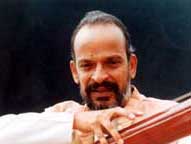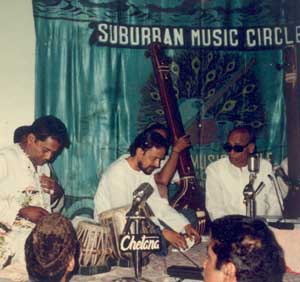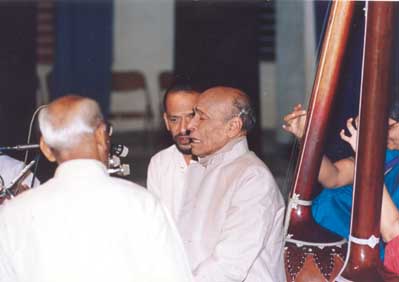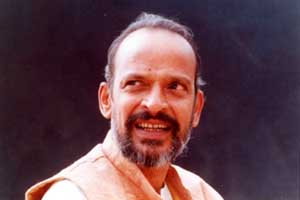Vocal

| Pandit Rajshekhar Mansur is not only the son of the legendary Pt. Mallikarjun Mansur of the Jaipur gharana of khayal but also a very talented and creative vocalist in his own right. |
Irfan Zuberi: You come from a very rich cultural region – Dharwad. In terms of any geographical region’s contribution to music, Dharwad probably features right at the top having given legends such as Pt. Sawai Gandharva, Pt. Basavraj Rajguru, Pt. Kumar Gandharva, Vidushi Gangubai Hangal, Pt. Bhimsen Joshi and your father Pt. Mallikarjun Mansur to the country. What is it about the region which makes it so special?
Pandit Rajshekhar Mansur: Many people have asked me this question. The reason in my understanding is socio-economic in character. The Mysore king Wodeyar (mid-19th century) was a great lover of music (Hindustani, Carnatic as well as Western) and he used to hold a 10-day music festival each year in Dussehra inviting musicians from North India. The journey was rather long and the musicians inevitably broke their journey at either Miraj or Hubli on the way to and on the way back from Mysore. There were a number of people in these towns who were connoisseurs of music and urged the Ustads to stay on for a few days to give concerts. This created a sort of an ambience for classical music which had an important part to play later on. Slowly, the general public began taking interest in the various art forms. The other reason is that our part of Karnataka, that of Belgaum, Dharwad and Bijapur, belonged to the Bombay Presidency before the states reorganization following the independence of India. For this reason, there was quite a lot of give and take from Maharashtra. A number of great musicians such as Pt. Bhaskarbua Bakhale came to teach music at the Training College in Dharwad where there was a teacher’s training programme. In fact, Pt. Bhaskarbua Bakhale went on to stay in Dharwad for a period of one and a half years taking up the cause of music. The third reason is the tradition of musical dramas in this region, again a contribution of Maharashtra. All the prominent musicians of this region took part in these dramas and this formed a major part of their own learning experience in the realm of Indian classical music.
These are some of the factors which contributed to the Dharwad region becoming a fertile crucible for music to develop in. Musicians such as Ust. Abdul Karim Khan saheb also visited Dharwad frequently. A big contribution was also made by the sages and saints in this region all of whom gave prominence to music and invited musicians to perform in religious festivals as seva.
IZ: It is a well-known fact that your father also learnt from Pt. Neelkanthabua of the Gwalior parampara. After that, he made the shift to the Jaipur-Atrauli tradition and learnt from the sons of the legendary Ust. Alladiya Khan saheb, Ust. Manji Khan and Ust. Bhurji Khan. I got to know that he also took some training in Carnatic music as well.
Pt. RM: No no, he did not learn Carnatic music in a systematic way at all! While he was part of the drama company which he had joined as a young boy of about 9 or 10, there used to be a Carnatic musician who used to come and give tunes to the various pieces. My father picked up a little from him over a period of about one and a half years or so. After that, he left for Miraj to learn from Pt. Neelkanthabua for a period of 10 long years. He then made a recording for HMV in 1932-33 singing raags Adana and Gaud Malhar and it was when this recording was played to Manji Khan saheb that he agreed to accept my father as his disciple.
IZ: How in your view was your father able to intertwine the styles of the Gwalior parampara along with that of the Jaipur-Atrauli tradition and then work towards developing a distinctive individualistic style of his own?
 |
Pt. RM: Let me start by saying that I place the four key gharanas – Gwalior, Agra, Kirana and Jaipur-Atrauli – at par with each other. In my understanding, these four gharanas form the cornerstones of the system of Hindustani music.
With his grounding in the rich Gwalior parampara, where equal importance is given to swar and laya, the foundation had been made upon which he could build. This does not mean that he found the stylistic approach of the Gwalior parampara unsatisfactory in any way; he just wanted more! Rajshekhar Mansur and his father Mallikarjun Mansur |
He had heard the gayaki of Ust. Alladiya Khan saheb as well as his son Ust. Manji Khan and it created a burning desire in him to learn this style of singing. What made things slightly easier for him is the fact that in Jaipur-Atrauli tradition also equal importance is given to swar and laya. The only difference is that of approach and interpretation. The approach of the Jaipur-Atrauli tradition is much more complex in terms of phrases, musicality, presentation (blending the various elements of khayal gayaki) as well as the rare aprachalit raags. Ust. Alladiya Khan saheb used to be a dhrupadiya and it is said that he lost his voice and did not know what to do. Legend has it that he saw Goddess Saraswati in a dream and regained his voice the next day and then turned his attention to khayal gayaki. He was a genius insofar as what appeared to be a disadvantage in his voice to many was used as an advantage by him so much so that he was able to establish a new gharana on the basis of his individualistic style. The complexity and intricacy of the style was part of the appeal and a challenge for my father. An added attraction was the repertoire of aprachalit raags which did not feature in the education of many other gharanas of the time.
IZ: Tell us a little about the specifics of the Jaipur-Atraulit tradition and its mode of presentation, styles of ornamentation, its repertoire of jod, aprachalit and sankeerna raags and your own understanding of its dynamics.
Pt. RM: For me, the Jaipur-Atrauli gharana is not a fixed system insofar as two people of the gharana do not sing alike. People ask me, „why do you call it a gharana then?” You see, the gharana is the foundation on top of which the musician has the freedom to develop a style based on his/her own capabilities. The basics always adhered to are the equal importance to swar and laya, starting off with the bandish itself and the elaboration of the raag depending upon the bandish. We ornament our unfurling and expansion of the raag based on the bandish. Our conception is that one bandish is one particular way of looking at a raag; another bandish may reveal a slightly different aspect of the raag. A slight misunderstanding is there in the minds of many regarding the centrality of aakaar in the gayaki of the Jaipur-Atrauli tradition. I have seen and heard Ust. Bhurji Khan use ookaar and eekaar regularly since these were the various elements of the dhrupad style which Ust. Alladiya Khan saheb picked up and incorporated into khyal gayaki.
In our style of singing, there is not much pause and leisurely development of the notes. We conceive of music as a continuum where one phrase leads to the other and so on till you are able to see it blossoming in different directions. We do not consider the various aspects of khayal gayaki as watertight compartments; the eight angs of khayal gayaki are very well knit and we do not make any attempt to disentangle this beautiful whole into the various parts. This has led many people to say that the singing of the Jaipur-Atrauli tradition is very cerebral in nature but not at the cost of the rasa and the stirring appeal to the heart. What we have acquired from our gurus is not just musical knowledge but a vision to create, improvise and present in ways which are fresh and new and it is this aspect which I would like to place most emphasis on. We place emphasis on the mool siddhant of the gharana but also urge the individual practitioners to mould creative identities of their own.
Let me tell you a little about aprachalit raags now. For me, the terminology jod is very problematic since no arithmetic addition of two or three raags takes place at all. An aprachalit raag is a very fine synthesis of two or more raags out of which a new raag emerges. These raags have an independence, autonomy and individuality of their own from the raags which they take elements from. For example, Raag Basanti Kedar is a transmutation of the two constituent raags in such a way that a third distinctive one emerges. Our gharana has a higher conception of these raags and we do not consider them to be mixed or jod at all. In fact, herein lies the greatness of the contribution of Ust. Alladiya Khan saheb who conceptualized these raags and presented them in a way that had never been thought of before!
IZ: I have noticed a fascination of the Jaipur-Atrauli gharana with what is called the nat-ang in raags be it Nat Kamod or Nat Bilawal or Nat Kedar or any of the other raags in which this nat-ang enters. Tell us a little about this aspect of the style of your gharana.
Pt. RM: That is an interesting question! No one has talked much about it but I think that Ustad Alladiya Khan saheb’s voice was a bit gruff and not too amenable to lilting movement. He must have thought about fashioning a new style and it was at this juncture that the nat-ang came handy to him because it does not have meend and jumps from one to the other like a staccato movement. I believe he would have been fascinated with this sort of jumping movement and since it was easy on his voice, he made full use of it.
IZ: Tell us about your own initiation into music. I have read that you did not start learning as a child as is usually the case. In fact, you started learning formally when you were in college.
Pt. RM: You must remember that even though my formal initiation into music might have been late by many standards, music always formed a part of my life right from childhood. I woke up to and went to sleep hearing my father doing his riyaaz. This is the crucial difference between the child of a maestro and a regular shishya. The sensory effects of the sounds I heard in childhood stayed with me and made a deep impression on me even if I did not want them to!
It is for this reason that I found it easy to pick up even though I started learning when I was 16 or 17. Most of the raags were like tunes for the children in the family much like the advertisement jingles are for today’s children. The familiarity and the sanskaar which I had from childhood helped me so much that right after I started learning, I appeared for my sangeet visharad examination and got a gold medal for topping. After that, I rendered vocal support to my father for a period of about 30 years. Most of my learning happened on the stage rather than at home since during the performance, I got a glimpse of the finished product that was my father’s singing. I always asked him to sing one or two raags which were proving to be a bit problematic for me at the time and it was in this way that all my doubts got cleared as well. Back home, I had the other advantage of having him around all the time and he could correct me at any time since I used to practice at home. He might be strolling in the garden outside smoking his bidi but would immediately yell, „Yeh aise nahin hai…aise karo!” That was the place from where I took off and it was because of this constant exposure that I was able to pick up faster than many other disciples of my father. He was a lover of the aesthetics in singing and taught me to appreciate the beauty inherent in our music.

Rajshekhar Mansur and Mallikarjun Mansur
He was also a perfectionist and would have no half-ways. It was for this reason that in the first couple of years of formal training under him, I brushed up all the fundamentals up to his satisfaction levels after which he encouraged me to improvise. Initially he told me to blindly imitate and gave me the reassurance that I would slowly get to see how the raag unfolds and expands and thus inflect it with my own creative inputs. The training I received was not a systematic structured classroom sort of education but more of a free-flowing accompaniment during which I had to find my own way and arrive at my own understanding of what I was singing. That proved to be very fruitful for me!
This way of learning impressed me so much that this is exactly the way I teach my disciples now. I never teach them phrase-by-phrase. I merely ask them to follow me and if they are unable to do a phrase, I leave it and ask them to focus on another one since the ocean of music is limitless. I have never made any notations of the compositions; the notes are in my mind and imagination and that is what I would like to inculcate in my disciples. A true guru is one who encourages you to do things differently and not merely imitate his style. One mission of mine has been to bring out those raags which my father also never sang in public thinking that these are private treasures of the gharana and not to be shared with others. It has been my attempt to bring out raags such as Lachari Todi, Lachhasaakh, Meghavali and others to the performance stage.
Another crucial thing is the fact that Indian classical music is not amenable to notation. How could you possibly measure the weight of rishabh in Raag Todi? It is not possible! It is for this same reason that I have a big issue with grammarians. They seem to think that grammar comes before music. It is the other way around. I say to them that we create the grammar on the performance stage which you can follow and write about.
IZ: You have been able to manage pursuing a career as a teacher of English at Dharwad University along with being a performing musician. Tell us how you have been able to strike this fine balance.
Pt. RM: I do not think of this as a great achievement of mine at all. Teaching was something I pursued as a career and a profession and music had always been there, like second nature. I had to invest a lot of time in teaching and it was a cultivated art but music was something always around which I could tap into anytime and have access to it. My father always encouraged me to have a profession away from music due to the struggles and financial irregularities entailed in this line.

IZ: How do you view the current scenario in Indian classical music. More and more people are of the opinion that the elements from the broad ‘culture industry’ – those of standardization and commercialization are making inroads into classical music as well.How do you see the future? It is good in one sense and bad in another.
Pt. RM: It is good insofar as there are many sponsorships now available which were not as easy to get in earlier times. The bad aspect is that there are now only a very few people who give music the kind of time it deserves and requires for an in-depth performance-level understanding. Genuine taleem is lacking. Students want to start performing in 2 or 3 years whereas it takes at least 10 years to develop and blossom into a performing musician!
The future holds mixed possibilities. While all sorts of rubbish is being passed on as classical music, there are some talented dedicated youngsters side by side who hold the key to the future of Indian classical music. The market forces have acted to the detriment of Indian classical music and that really needs some change. I tell my students, „Pet ke liye kuchh kaam karo aur shauq ke liye sangeet ko haasil karo!” It has become very difficult for students of music in this day and age to sustain themselves on music itself since the opportunities are very meager. Scholarships need to be instituted for young deserving students as encouragement. Corporate houses can do a lot in this regard and it is not much to ask for from them.